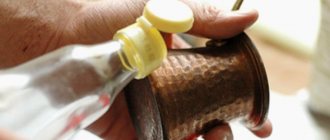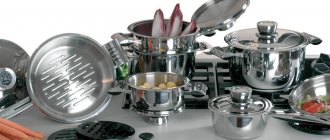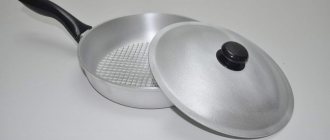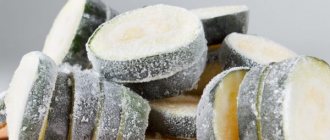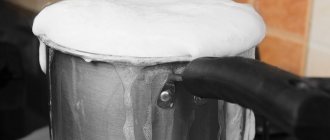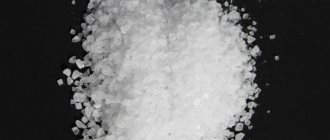Non-stick pans are in great demand. They do not require complex care, and the prepared dishes are tasty and contain a minimal amount of fat. However, over time, the products become dirty and plaque appears. In order not to compromise the integrity of the material, you should learn how to properly clean a non-stick frying pan inside and out.
Features of non-stick coating
Frying pans can have the following coating options:
- Teflon (polytetrafluoroethylene). Teflon cookware is lightweight, easy to use, and you don’t need to add oil for cooking. Disadvantages of Teflon products: polytetrafluoroethylene cannot be heated too much, otherwise under the influence of high temperatures it will release harmful substances. You should be careful not to use sharp objects to avoid damaging the Teflon coating.
- Ceramic. To make it, manufacturers use a nanocomposite polymer with the addition of sand nanoparticles. Ceramic frying pans can be heated to any temperature without harm to health, unlike Teflon products. Ceramics are chosen by supporters of a healthy and proper diet, because they can be used to cook dishes without adding fat. Negative aspects of ceramics: it is afraid of damage, falls, and sudden temperature changes. Ceramic cookware should not be washed in dishwashers, and the use of alkaline detergents is not recommended.
- Marble – a coating made of polytetrafluoroethylene with the addition of tiny marble chips. A frying pan with such a coating is light in weight, is not afraid of high temperatures, and takes a long time to cool down. Marble-coated cookware has a longer service life than ceramic or Teflon. The disadvantage of marble kitchen utensils is the rather high price.
- Titanium and diamond coatings are the most expensive options that will last in the kitchen for at least 20-25 years with proper care. They are not afraid of sharp objects or falling, they can be washed in the dishwasher. They are expensive and are not used on induction cookers.
Ceramic
Marble
Teflon
Titanium
How to get rid of “fresh” soot
If heavy carbon deposits have formed on the frying pan during cooking, you can get rid of grease stains at home by washing it in the dishwasher. However, not every kitchen has a similar unit, but you can use it in the following ways:
- You will need pharmaceutical borax (10 g) and ammonia (5 drops). Dissolve the substances in one glass of warm water, and, dipping a foam sponge into the solution, clean the pan.
- Pour warm water into a bowl and add 1 tablespoon each of baking soda and mustard powder. Leave the pan for half an hour, then wash thoroughly with a foam sponge.
- If the frying pan is very burnt, it is not always possible to wash it immediately. Fill a bucket or basin with warm water and leave the dishes to “soak” overnight. After this, wash with a sponge and dishwashing detergent.
Remember that Teflon pans do not tolerate sudden changes in temperature and start cleaning or washing them in the dishwasher only after they have cooled down. Also, you cannot use hard dish sponges and abrasive powders, this will damage the coating and it will be impossible to restore it.
Possible contamination
Housewives love non-stick cookware and use it every day. But over time, the food in your favorite frying pan begins to burn. Not many people know what to do in such cases, and often immediately buy a new product.
What can cause soot to appear:
- Incorrect operation;
- Failure to follow the rules for washing non-stick coatings;
- Using sharp objects to mix food in containers.
A layer of fat and soot is deposited on both the inside and outside of the frying pan. The danger of soot is as follows: when heated, it begins to release carcinogens that negatively affect health.
What other problems may arise with your favorite frying pan:
- Over time, nonstick cookware becomes coated with a layer of sticky grease. It is especially surprising when this happens to good housewives, because they thoroughly wash the dishes after each use. Unfortunately, it is almost impossible to completely remove grease from a frying pan, so it needs to be properly cleaned periodically.
- Rust appears on the non-stick coating. If you do not thoroughly dry the product after washing, rust stains will form on it, which will subsequently be difficult to remove.
- Remnants of burnt food. The pan should be washed thoroughly after each use. If there are burnt foods on the coating, they should be completely removed without damaging the non-stick layer.
Let's figure out how to clean non-stick frying pans from carbon deposits on the outside and inside.
Nagar
Remnants of burnt food
Rust
How can the coating of a frying pan become dirty?
When dishes are actively used, they cannot escape contamination. Residues of oil after frying, dough, drops of jam, etc. - every housewife is familiar with this list. Despite the fact that cooking in such a frying pan requires a minimum of fat or oil, it should still be cleaned after each use. And then the question arises for every housewife - how to clean a frying pan with a non-stick coating?
The Teflon coating is easy to scratch, so do not use acids or alkalis.
Important! The non-stick coating is specially designed for ease of care and cooking; resistance to dirt is one of the main qualities. If you notice that the frying pan has become more susceptible to contamination inside, or that it has become more difficult to clean, be sure to take a closer look at the coating applied. Most likely it is damaged. In this case, the frying pan is not recommended for use, especially Teflon. Unfortunately, it needs to be replaced.
Methods for cleaning the inside of a frying pan
At first glance, it may seem that it is much easier to clean the inside of the frying pan. But you should be very careful not to damage the non-stick coating during the cleaning process.
Never use cleaning products that contain abrasive particles, which can scratch the non-stick coating. Use universal methods for cleaning non-stick cookware that remove layers of fat, carbon deposits, and old stains. We offer several ways to clean a non-stick frying pan without damaging it.
Laundry soap
This affordable method requires only inexpensive laundry soap. It can be purchased in almost every store. Grate a quarter of a bar of soap, pour the soap shavings into the frying pan, and pour in water. Send over low heat, wait until it boils and immediately remove from the stove. Let the soap solution sit in the dish for several hours until it cools completely. Pour out the solution and wash the pan with a soft sponge. For best results, use a small amount of dishwashing detergent.
Boiling with soda
How to clean a non-stick frying pan with baking soda:
- Dissolve 5-6 teaspoons of soda in one liter of clean water.
- Pour the solution with soda into a frying pan, place it on the stove, and wait until it boils.
- The solution should boil in the container for about 20 minutes.
- When the solution has cooled, pour it out and remove the carbon deposits with a soft sponge.
Soda and dishwashing detergent
How else can you clean a non-stick frying pan from carbon deposits at home? Make a weak soda solution with a few drops of liquid detergent. Pour into a frying pan, put on the stove, wait until it boils. As soon as the mixture begins to boil, turn off the stove and leave for about an hour. Then pour out the contents, rinse the product under running water, and remove any remaining burning and grease with a soft sponge.
After the procedure, many housewives pour water into the cleaned dishes and let them simmer on the stove to completely remove the detergent from the surface.
Soda and office glue
Many people are afraid to use glue so that its particles do not end up in food. In reality, office glue is not dangerous for the non-stick coating; it is completely removed from the surface and returns the frying pan to its original appearance. How to clean a burnt non-stick frying pan using glue and baking soda? To do this, separately mix a standard tube of office glue and 1/3 of a pack of soda. Fill half the pan with water. Add glue and soda to the water, bring to a boil, leave on low heat for about half an hour. Depending on the degree of contamination, you can boil the solution for up to 45 minutes. Leave the solution for a few more hours to cool. In case of heavy carbon deposits, leave the solution overnight and clean the pan with detergent in the morning.
Activated carbon
To clean the frying pan from light dirt, use white and black coal, as well as the drug “Polyphepan”. The package of tablets should be crushed into powder and poured onto a dry surface of a frying pan.
Pour in warm water, leave for several hours, then pour out the contents and wash the inner surface with detergent. If the stains have not disappeared, the procedure must be repeated, only the frying pan with coal must be placed on the stove and allowed to simmer for a few minutes.
Cleaning carbon deposits inside
The gentlest way to clean a non-stick frying pan from carbon deposits inside is to use vinegar and soda. These 2 products are available in every household and, in addition to culinary use, help with cleaning.
Pour water into the pan, add 1 tbsp. vinegar, bring to a boil. You will see the carbon deposits begin to come off. Remove the dishes from the heat, add 2 tbsp. l. soda Wait until the mixture starts to foam. Wait 15 minutes, then wipe with a sponge or soft cloth.
Boiling with soda
Soda is the best helper in the kitchen.
It easily breaks down fat deposits, and the dishes acquire their original shine:
- Dissolve 5 tsp in a 1 liter container. soda
- The soda solution is poured into a frying pan and boiled for 20 minutes.
- Remains of burnt food are removed with a soft sponge after the mixture has cooled.
How to clean the outside
How to clean the outside of a non-stick frying pan? Preference should be given to household chemicals. Try to clean in such a way that detergents do not get inside the pan.
Choose special concentrates and sprays for non-stick pans. The concentrate must first be foamed, applied to the outside of the dishes and left for 15-20 minutes, and then rinsed thoroughly with water and a soft kitchen sponge. It is more convenient to use a spray: it is sprayed directly from the container onto the contaminated surface, and after 5-10 minutes it is washed off with water.
If the pollution is not too strong, you can use traditional methods. Knowing how to clean the outside of a frying pan with a non-stick coating from carbon deposits at home, you can do this without much difficulty:
- Take a large saucepan and pour water into it. Add grated shavings from two pieces of laundry soap, as well as two packs of baking soda. Place a frying pan in a soap-soda solution, put the pan on the fire and boil for two hours. After this, turn off the heat, let the contents of the pan cool, and remove the pan. Soot and stubborn fat should be easily removed with a soft sponge or piece of cloth.
- Pour 3 liters of clean water into a large container. Add 50 ml of office glue, 100 ml of detergent, 150-200 grams of soda. Place the frying pan in the resulting solution, hold for several hours, then rinse the frying pan under water. Remove heavy dirt with a sponge.
The best ready-made products
Modern people prefer to save time and energy by buying special products for cleaning soot on a frying pan. Today there is a wide selection of chemicals that can quickly get rid of fat. But it is important to remember that they all contain components that are not always completely washed off with water, and therefore are harmful to health. Therefore, it is recommended to use chemicals in minimal quantities.
Carbon deposits from a non-stick frying pan can be cleaned using the following means:
- Schumann;
- Antinagar;
- Milam;
- Domestos et al.
Removing old stains
Even old dirt can be removed from the non-stick coating using available tools. How to clean a non-stick frying pan with carbon deposits and a large layer of accumulated fat:
- Borax + ammonia. You will need 250 ml of ammonia and borax. Mix borax and ammonia, apply with a cotton swab to the inside and outside of the dishes, wait half an hour, and then wash off the dirt with a sponge and detergent.
- Toothpaste. Regular toothpaste is suitable and should be applied evenly to the stains. When the deposit becomes soft, it can be easily washed off with water and a small amount of liquid soap.
- Ethanol. Soak a piece of soft, clean cloth in ethyl alcohol and gently rub the contaminated areas. When the carbon deposits and grease leave the walls, all that remains is to wash the product under the tap.
Cleaning rules by type of coating
Frying pans are made from a variety of materials. And so that cooking is not complicated by constant burning, you need to follow the rules for caring for dishes.
Teflon is considered the most reliable material. The inner and outer parts of the frying pan are protected from carbon deposits. But even on it, small fat deposits appear over time.
Aluminum
Aluminum products require special care, since the wrong product can damage their surface.
For cleaning, do not use alkaline substances or products with a high content of acids. Also, the integrity of the surface is compromised when aggressive chemicals are used. And the steam emanating from them can cause poisoning.
Be sure to read:
How to clean the outside of a stainless steel kettle: the best folk and chemical remedies
Teflon
A hard sponge or aggressive substances cannot be used to clean Teflon-coated products, since the coating on the surface is very thin and fragile.
To remove traces of carbon deposits, pour water into a frying pan and boil it. Traces of soot will be easier to clean if you add a few drops of detergent to the water.
Ceramic
Ceramic products are very popular among consumers, but such dishes are very difficult to care for and are easily damaged. Due to damage, food begins to burn to the surface.
Cleaning such products is difficult because it must be done carefully. Special products are produced for gentle cleaning of ceramics and safe removal of carbon deposits.
Non-stick
Non-stick frying pans cannot be cleaned with a concentrated solution of citric acid, pure vinegar or chemicals that contain alkali and acid.
The coating deteriorates if the hot product is cooled sharply under cold water.
Cast iron
Products made from cast iron are the most reliable and safe for humans.
They have a long service life. The frying pans are easy to care for; it is enough to occasionally remove carbon deposits from their surface.
Cleaning can be carried out by any method, since the coating has good resistance to abrasive particles and metal. Suitable detergents are substances intended for steel products.
Features of care taking into account the material of the pan
In order for non-stick cookware to serve for a long time, you need to follow simple rules:
- Immediately after purchase, rinse the frying pan thoroughly under warm water without using aggressive detergents. Dry the dishes thoroughly and leave until completely dry.
- To maintain its non-stick properties, it is necessary to thoroughly clean the frying pan to remove any remaining food and grease after each use. Dirt should not dry to the surface, so dishes should be washed immediately after use.
- Wash non-stick cookware with soft sponges using gentle cleaning agents without adding abrasive particles. It is contraindicated to use metal sponges; they can scratch the surface.
- Hot dishes should not be washed with cold water. You need to wait until it cools down and only then start washing.
- All instructions from the manufacturer must be followed. It is advisable to purchase non-stick cookware from branded stores to be sure of its quality.
What not to use to clean non-stick surfaces
To ensure that the anti-burn properties are preserved for a long time, choose delicate cleaning methods. Avoid using formulations that contain large amounts of acid or alkali. Together with the fat, they will also corrode the coating. Avoid hard brushes and sponges, as well as products with abrasive particles. They may leave scratches.
If trouble occurs and the protective layer is damaged, follow the procedure to restore it. Using a brush, lubricate a clean, dry product with vegetable oil (on all sides). Try not to miss a single millimeter. Then place the pan in an oven preheated to 200 °C for 60-120 minutes. After the specified time has passed, turn off the appliance. Do not remove the dishes until they have cooled down. The resulting protection will prevent rust and food from sticking. If this does not help, you should get rid of the dishes.
Operation and prevention
In order not to waste time on lengthy cleaning of old fat and carbon deposits, follow the basic rules for using non-stick cookware. This will help maintain the non-stick coating and maintain the original appearance of the cookware.
- After cooking, wait until the product has cooled completely, then wipe the bottom and walls with a soft sponge and a gentle detergent. After all, carbon deposits are nothing more than a layer of fat that was not removed from the dishes in time.
- Non-stick cookware should not be heated too much. In many products, when heated above 250 degrees, the non-stick properties are lost.
- Do not use sharp knives, metal cutlery or spatulas as they may damage the non-stick surface. To stir the dish, you will need a silicone, plastic or wooden spatula. You can buy special tongs with protection for Teflon cookware.
- To prevent dirt and grease from accumulating on the walls and bottom of the cookware, you should thoroughly clean it once a month. How to clean non-stick pans is up to you, there are many options.
- If, after thorough washing, the food still burns, it is better to buy a new frying pan, since the destroyed non-stick layer will release substances harmful to health during the cooking process.
Non-stick cookware greatly simplifies the cooking process. But you should know how to properly care for it, how to clean it, what products to use. If you use the frying pan according to all the rules, it will last quite a long time, maintaining its non-stick properties.
Preventing carbon deposits
If you regularly take preventive measures against the formation of fat deposits and soot, the need for cleaning will decrease.
Care instructions:
- The pan is washed every time after use.
- Spoons, spatulas and other accessories made of metal cannot be used.
- Excessive overheating will deform the frying pan, so overheating should not be allowed above +250 °C.
- Once a week, the outside of the product is washed with a chemical detergent.
Cleaning carbon deposits from the outside
Old grease and hard-to-remove deposits on the outer surface of the frying pan can be easily cleaned with special powders, chemicals and abrasive sponges. The cookware does not have a non-stick coating on the outside, so there is no need to worry about aggressive agents. The main thing is that chemicals do not come into contact with the inner surface.
Products for cleaning carbon deposits from the outside:
- spray: “Mr. Muscle”, Sano Forte plus, Unicum Gold, Sion;
- gels and cream: “Domestos-cream”, “Antinagar”, Synergetic, Sanita, Tytan
- foam: Amway Dish Drops, Nihon Detergent;
- powder: Pemolux, Pemoxol, Mario;
- liquid: “Milam”, “Shumanit”, Azelit, Mister Dez Eco-Cleaning.
Special ones are available for sale:
- two-layer sponges for washing Teflon pans: one side is porous, the other is hard plastic;
- single-layer porous in a shell made of polypropylene thread;
- metal sponges with and without special impregnation.
Daily care
To avoid having to waste time dealing with scale in a Teflon frying pan, it is better to constantly monitor the dishes.
After eating, don’t be lazy, and rinse not only the plates.
Using gentle, gentle movements, wash off the fumes from the outside and inside using mild detergents. You can wipe with natural apple or lemon juice. And then rinse in clean water.
If necessary, boil the frying pan in an aqueous solution of soap or citric acid. Thoroughly clean the outside with pastes.
It only takes a little time to care for a non-stick frying pan. Clean the inside every time after cooking. It is enough to clean the outside just once a week.
If you don’t want to bother with the dishes, just wash them in the dishwasher every time after use. And the frying pan will always shine clean.
One more little tip. After some use, you need to monitor how quickly scale forms on the inside of the pan.
If this happens every time after cooking, it means that the non-stick layer has been damaged. You should not use such utensils. It's better to throw it away and buy a new one.
Recommendations for caring for dishes
Any cookware should be washed after it has cooled; you should not expose the non-stick coating to sudden changes in temperature. If you immerse a frying pan in cold water just removed from the stove, it may become deformed, the coating may crack, and further use of such utensils will no longer be safe and ineffective.
It is unlikely that you will be able to stop using a Teflon frying pan, given its well-founded advantages and uniqueness.
Before soaking and boiling, it is better to unscrew or remove the removable handle, or simply do not immerse it in water. Don't forget that handles are often made of a different material and have different care requirements.
Sources
- https://chistyulka.ru/uhod/kak-otmyit-skovorodu-s-antiprigarnyim-pokryitiem-ot-nagara-vnutri
- https://rem.ninja/kuhnya/uhod/ochistit-antiprigarnuyu-skovorodu-ot-nagara.html
- https://posuda-gid.ru/chistka/178-kakpochistit-skovorodu-s-antiprigarnym-pokrytiem
- https://berkem.ru/posuda/kak-ochistit-skovorodku-s-antiprigarnym-pokrytiem/
- https://posudaa.ru/posuda-dlya-prigotovleniya/skovorody/chistim-antiprigarnoe-pokrytie-vnutri-i-snaruzhi
- https://Otbelim.com/vyvedenie-pyaten-i-tsarapin/zhir-i-nagar/kak-ocistit-skovorodu-s-antiprigarnym-pokrytiem.html
- https://uborka-v-dome.ru/pravila-chistki/skovorodka-s-antiprigarnym-pokrytiem.html
- https://zen.yandex.ru/media/id/5db5b83f34808200b0a60071/5dc8eb69e161f40e7bb6c8f5
- https://trudogolikam.ru/bytovye-sekrety/kak-ochistit-skovorodu-ot-nagara-i-zhira-v-domashnix-usloviyax.html
- https://posudaguide.ru/chistka-i-uhod/skovorodki-s-antiprigarnym-pokrytiem-vnutri-i-snaruzhi
- https://nisorinki.net/kak-pochistit-skovorodu-s-antiprigarnym-pokrytiem-vnutri-i-snaruzhi/
The salty way
Do you know how they used to clean frying pans? They poured a thick layer of coarse salt on the bottom, put it in the oven and heated it. After cooling, the salt was removed and the bottom of the dish was wiped with a cloth. No water was used at all. But neither the pancakes nor the cutlets burned. This is how cast iron frying pans acquired non-stick properties.
The method is not suitable for modern non-stick cookware, but its details were used as a basis. Salt is a great fat dissolver, so boiling salted water in a frying pan for 5 minutes gets it spotlessly clean.
The method can be varied - add a little soda to the salt, things will go faster.
Important! Calcination of salt on a dry non-stick surface is prohibited; the coating will crack.
Baking soda is as popular as salt in its ability to dissolve fat. And it removes carbon deposits even better. Let's talk.

